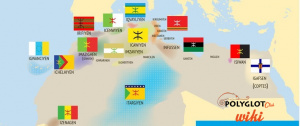Language/Kabyle/Vocabulary/Food-items
Introduction
In this lesson, you will learn vocabulary related to food items in Kabyle. Kabyle cuisine is rich and diverse, with influences from various cultures and regions. Learning the names of different foods will help you navigate menus and grocery stores, and is an important part of understanding Kabyle culture.
Fruits
Common fruits in Kabyle
Here are some common fruits you might encounter in Kabyle:
| Kabyle | Pronunciation | English |
|---|---|---|
| ḥessu | /ħeːs.u/ | apple |
| tabburt | /tab.burt/ | pear |
| 'ifel | /ʕi.feːl/ | grapes |
| zitun | /zi.tuːn/ | olive |
| nwen | /nwen/ | orange |
| ttarza | /tːar.za/ | peach |
Exotic fruits in Kabyle
Kabyle cuisine also features a range of tropical and exotic fruits, some of which may be less familiar to Westerners. Here are a few examples:
- tinifri - pineapple
- ahilu - avocado
- fawiqus - passion fruit
- talentalt - papaya
- blaḥ - fig
- timẓukt - watermelon
Vegetables
Common vegetables in Kabyle
Kabyle cuisine is known for its fresh and flavorful vegetables. Here are some commonly used vegetables:
| Kabyle | Pronunciation | English |
|---|---|---|
| bǧin | /bɣin/ | tomato |
| Xlefa | /χlɛfa/ | lettuce |
| xesṭum | /χɛs.tum/ | onion |
| tunṭa | /tun.t̻a/ | potato |
| Xuruqim | /χur.qim/ | cucumber |
| kermus | /kɛr.mus/ | beet |
Exotic vegetables in Kabyle
In addition to its native vegetables, Kabyle cuisine also incorporates a number of exotic vegetables from around the world. Here are some examples:
- avkukay - avocado
- kicẓ - mushroom
- tysnayt - asparagus
- lhbabost - okra
- uzdaẓul - eggplant
- Xulǧan - chili pepper
Meats and proteins
Common meats in Kabyle
Kabyle cuisine includes a variety of meats, with lamb and beef being the most commonly used. Here are a few common meats you may encounter:
| Kabyle | Pronunciation | English |
|---|---|---|
| aɣrum | /aɣrum/ | beef |
| uɣur | /uɣur/ | lamb |
| yisli | /jis.li/ | chicken |
| iseggwasen | /is.ɛɡ.ɡwa.sən/ | fish |
| yezzeɣ | /jɛz.zeɣ/ | shrimp |
Legumes and other proteins
In addition to meat, Kabyle cuisine also features a range of vegetarian and vegan proteins, such as:
- izirargen - lentils
- ayḍas - chickpeas
- lupia - beans
- iqqarsen - nuts (such as almonds and walnuts)
- boulgourth - bulgur
Breads and grains
Bread is a staple of the Kabyle diet, with various types of flatbreads and loaves being used in meals throughout the day. Here are a few different types of bread you may encounter:
- kesra - a flatbread made from semolina flour
- aghroum - a round, dense bread made from wheat flour
- aqsuqi - a sweet biscuit made with almonds and honey
- asmsi - a type of pancake made with cornmeal
In addition to bread, Kabyle cuisine incorporates a range of grains and cereals, including:
- semqa - barley
- sselqa - corn
- qxuq - oatmeal
- aqjul - rice
- tlina - couscous
Dairy products
Dairy is an important part of Kabyle cuisine, with various types of cheeses and yogurts being used in different dishes. Here are a few examples:
- aghrawas - a soft, spreadable cheese
- axagas - a mild, fresh cheese
- taknayt - buttermilk
- assekkur - a thick, strained yogurt
Sweets and desserts
Kabyle sweets and desserts are known for their combination of sweet and savory flavors. Here are a few examples:
- tighrifin - a type of pastry made with almonds and honey
- aṣṣūf - a type of nougat made with nuts and honey
- taluft - a type of nougat made with sesame seeds and honey
- uftaḍ - a type of cookie made with semolina flour and almonds
- Lbesti - a type of cake made with semolina flour, milk, and almonds
Conclusion
In this lesson, you learned the names of various food items in Kabyle, including fruits, vegetables, meats, and more. As you continue to study Kabyle, you will encounter these foods in settings such as grocery stores, restaurants, and homes. Building a strong vocabulary foundation is an important step in achieving fluency in the language.

